In part 1 of the series, it was shown that edge-trailing and edge-leading strokes on a hard, flat abrasive hone lead to entirely different processes for apex formation and refinement. The edge trailing (stropping) stroke allows a keener apex to form by avoiding the micro-chipping that occurs in edge-leading strokes. However, the edge-trailing stroke can lead to the formation of a foil-burr while the micro-chipping that characterizes an edge-leading stroke generally limits the formation of a foil-burr.
In part 2 of the series, it was demonstrated that the use of a compressible substrate (a strop) produces micro-convexity and can avoid the formation of the foil-burr that is usually produced when performing edge-trailing strokes on an in-compressible substrate. This micro-convexity typically improves keenness and apex uniformity.
In part 3 of the series, it was shown that the amount of micro-convexity is determined primarily by the choice of strop material. It was also demonstrated that partial or incomplete micro-convexing of the apex can produce a foil-burr (as in the case of 0.25 micron diamond on leather, for example). It was also observed that the effect of stropping is rapid (requiring only a few strokes) and that further stropping (up to hundreds of strokes) has minimal additional impact.
In this edition of the series, the role of abrasive size (grit) is examined. In particular, it will be shown why stropping a straight razor with metal polish on denim is so effective, despite being seemingly contrary to the common “wisdom” of internet experts.
Some time ago, I purchased a stick of “Thiers Issard Pate a Rasoir” stropping compound. This white crayon-like stick of aluminum oxide abrasive in a waxy carrier is fairly well regarded among people who have used it on their straight razors. The product is usually described by retailers as being “10,000 grit” (abrasive particles in the vicinity of one micron). When analyzed by SEM, the abrasive is clearly much coarser than 10k grit – there were many particles in the ten micron range and I found one as large as 100 micron.
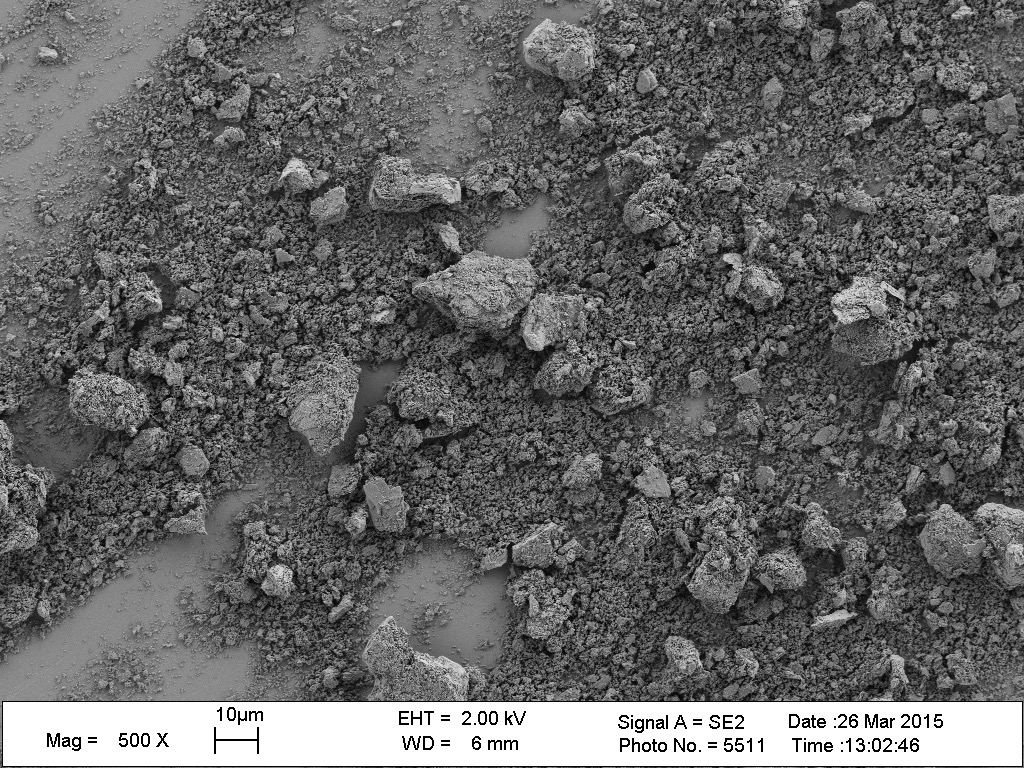
Despite being far coarser than advertised, I applied the product to a hanging strip of denim and worked it into the fabric with the spine of a razor. The razor was honed on a progression of Shapton glass plates to 16k (producing a triangular bevel) and then stropped for 30 laps on the loaded denim. This razor has a 16.5 degree innate bevel angle and after stropping, the angle measured 20 microns from the apex has increased just one degree. This increase in angle is a result of a very slight bevel convexity resulting from the use of a hanging strop.

The induced micro-convexity is evident where the angle is measured at 3 microns from the apex and observed to increase by 8 degrees from the innate angle. Micro-convexity is produced independently of the larger scale bevel convexity. The apex is relatively clean with minimal burring and keenness sufficient for shaving.

When comparing the effect of different abrasives, we need to minimize the impact of other variables. We can use the same strop material, and the same length and number of strokes; however, the downward pressure is a challenging variable to control. The three images below were presented in Simple Straight Razor Honing and demonstrate that downward pressure plays a determining role in the amount of micro-convexity produced on a particular strop.

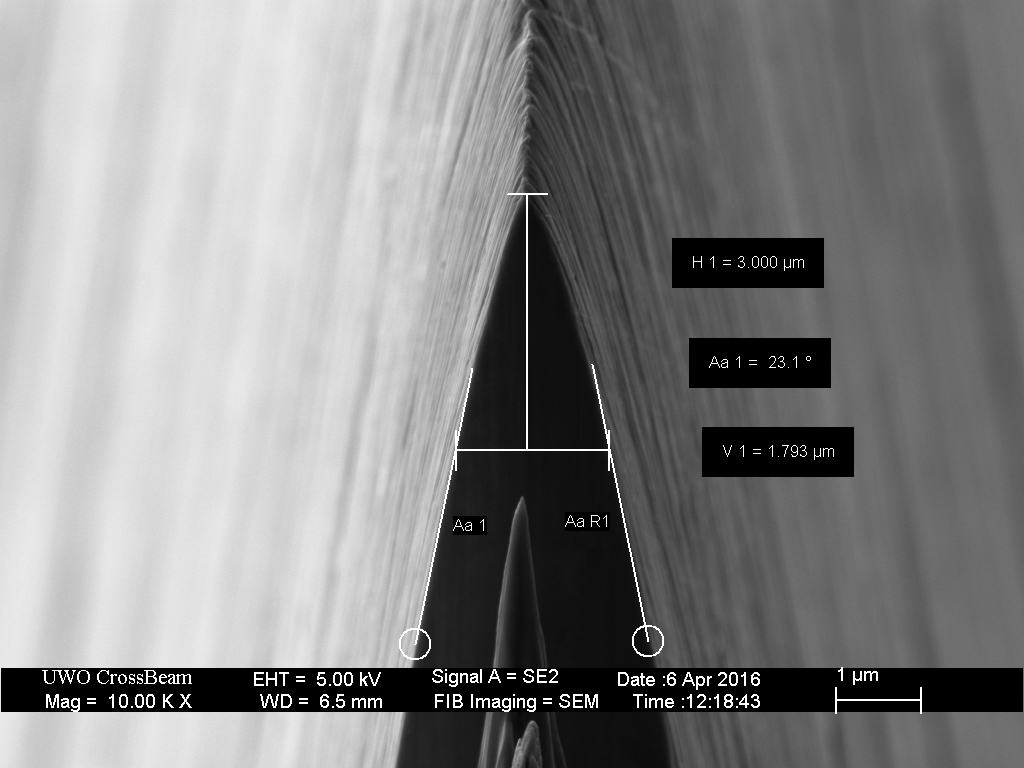
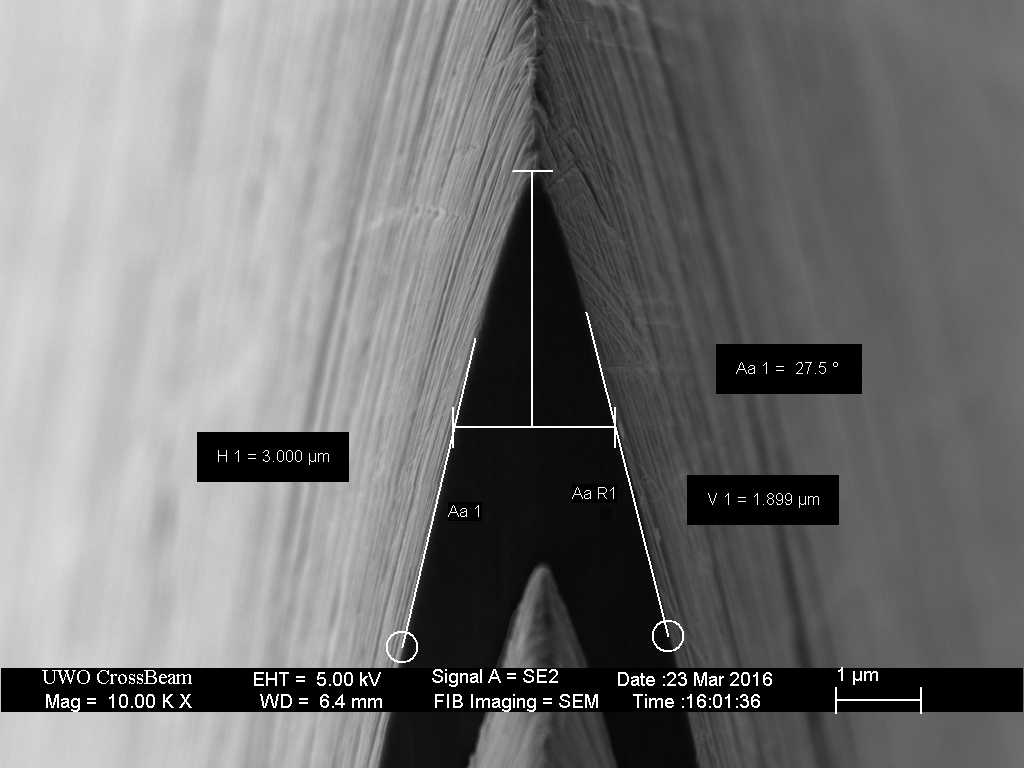
In the experiments that follow, I have made every effort to maintain the pressure in the normal range (100-150 gram equivalent), and repeated the tests with different razors to confirm the observed trends are repeatable.
Over the past two years, I have tested a variety of other metal polishes on denim strops (Mother’s, Flitz, Simichrome, Wenol, Pikal to name a few) and all have performed and analyzed similarly. The example below shows a blade honed with the Shapton 16k and then stropped 30 laps on a Mother’s Mag polish loaded strip of denim. The result is nearly indistinguishable from that produced by the TI white razor paste.


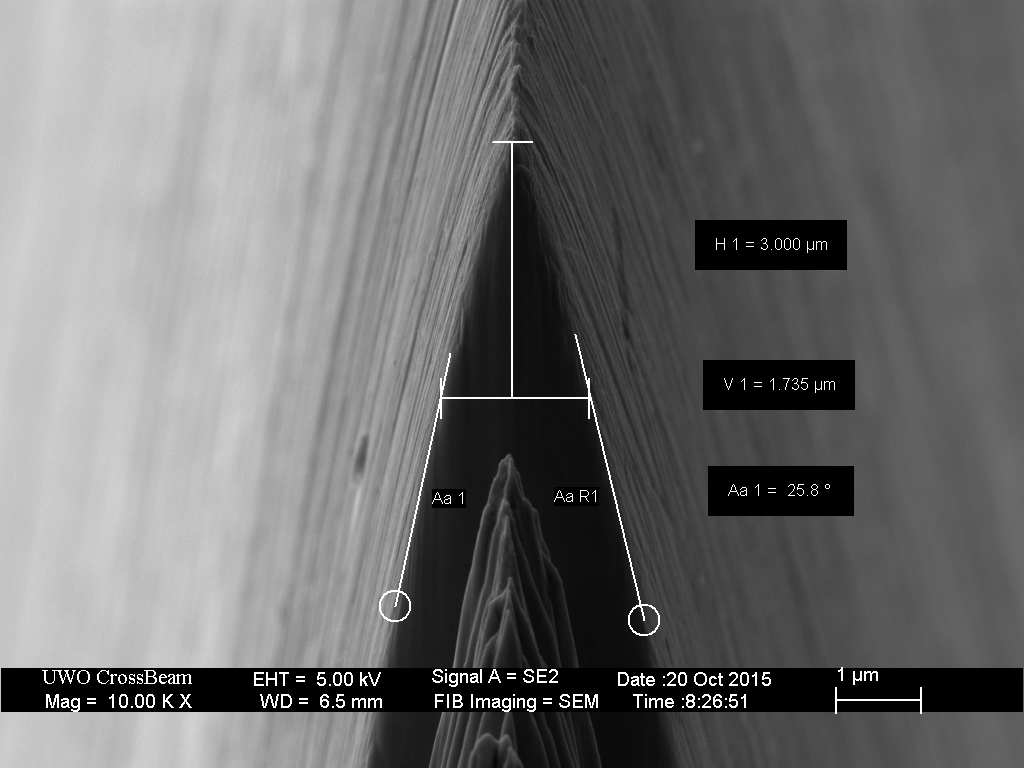
The are two obvious questions that arise from the results above. First, why is the result so insensitive to the choice of stropping compound? and second, how is such a keen edge produced by such coarse abrasive? To provide some insight, I compared the effect of denim strops loaded with diamond abrasive ranging from 0.1 microns up to 15 microns.
Prior to performing this particular experiment, I had two experiences with very surprising results. The first involved the use of the Thiers Issard razor paste. After using the Thiers Issard pasted strop for 30 or 40 razors, the strop had become glazed and seemed to be less effective than when new. Rather than making a new strop, which is now my habit, I “re-loaded” that strop by rubbing the abrasive “crayon” lightly over the stropping area and working it in with the spine of a razor, as usual, and then stropped a C135 steel Thiers Issard razor, one that I have used regularly for several years. After 30 laps on the TI-pasted denim, I proceeded to strop the razor on the 0.25 diamond sprayed leather and the stropping both felt and sounded rough. Inspection with a loupe and feeling with my thumbpad revealed that the edge of the edge had been broken away at a relatively coarse level. So much damage had been done that reseting the bevel required a substantial amount of steel to be removed, as much as is usually required when restoring a vintage razor. SEM imaging had shown that the paste contains particles of up to 100 microns, and these are more than capable of destroying the edge of a straight razor, but had not done so prior to re-loading the strop.
The second surprising result came when I began testing coarse diamond loaded strops. I purchased a set of inexpensive diamond pastes (the ones that cost one dollar each, shipped from China). I analyzed several of them by SEM and found that the size distribution was excellent, in fact better than some products that had cost me 50 times as much.

I loaded a strip of denim with the 10 micron diamond paste and stropped a razor honed to the 8k level, and was astonished to find that the strop had essentially no effect.
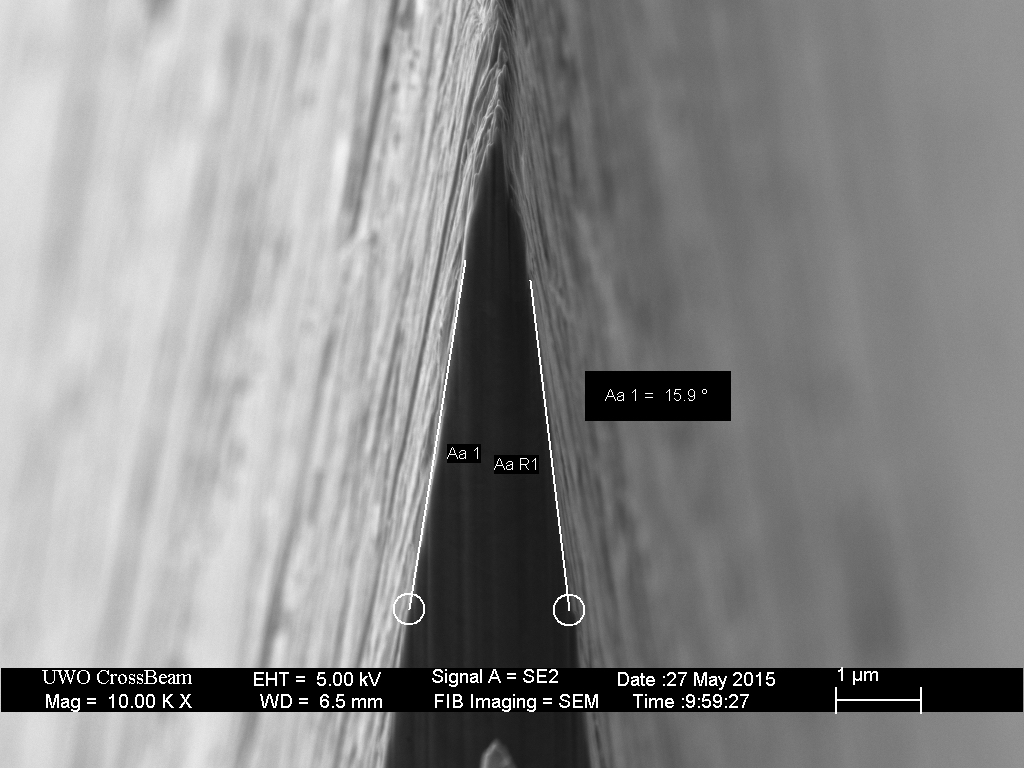
It is challenging to quantify the concentration of diamond in a product, particularly in an oil-based paste. The obvious hypothesis is that this product may have good size distribution, but low concentration. Moving forward, I acquired a set of “scientific” quality, high concentration, poly-diamond sprays with sizes ranging from 100nm to 15 microns.
In the set of images that follow, a razor was honed with Shapton glass stones up to the 16k level to produce a keen triangular apex, one that would easily demonstrate the effect of stropping – the induced micro-convexity and any effect on the apex. The razor was then stropped, 30 laps, on a strip of hanging denim loaded with the particular sized diamond abrasive. As a control, the effect of clean (no diamond) denim is also shown.


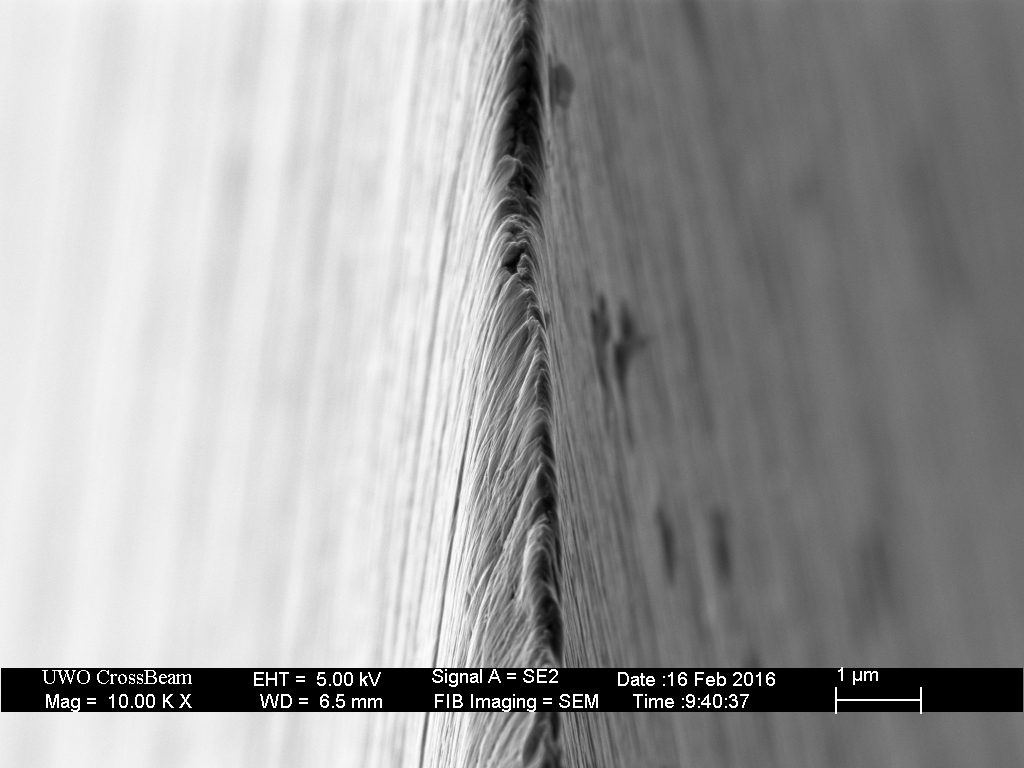

In the subsequent images, stropping with progressively coarser poly-diamond spray is characterized.
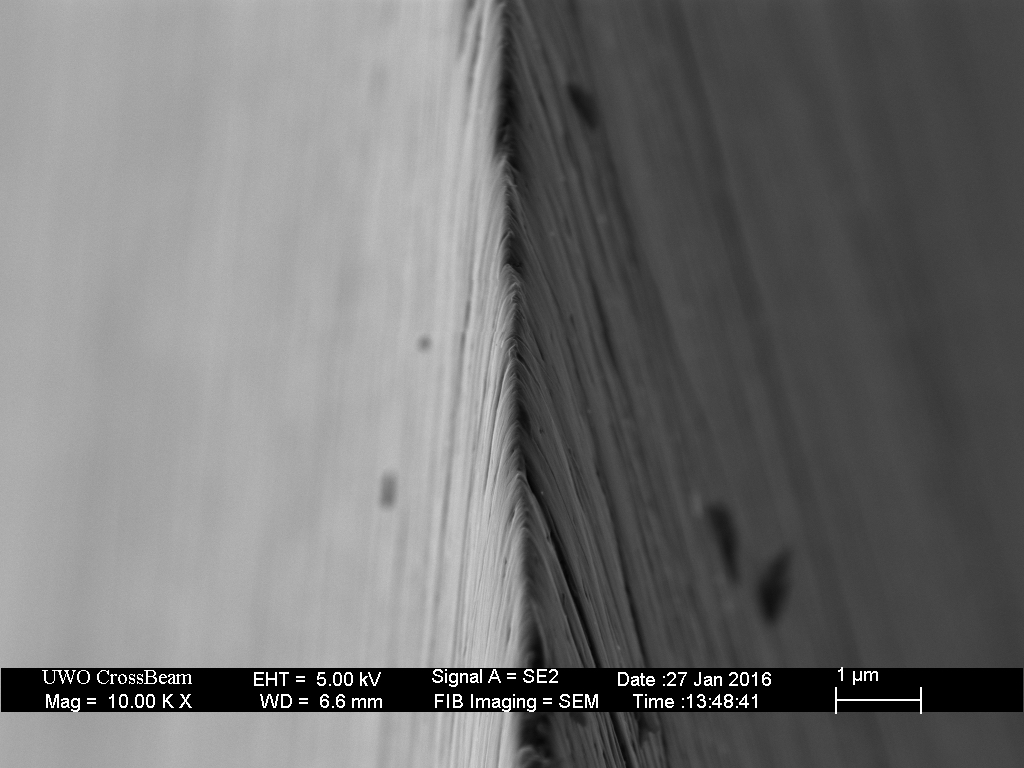
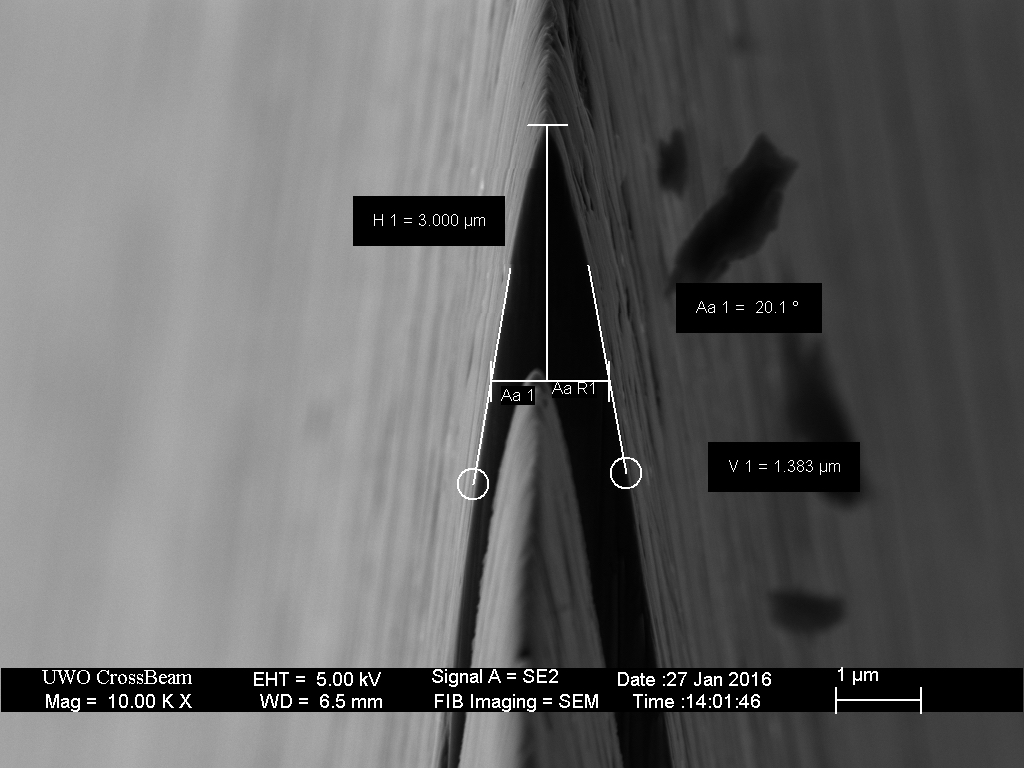

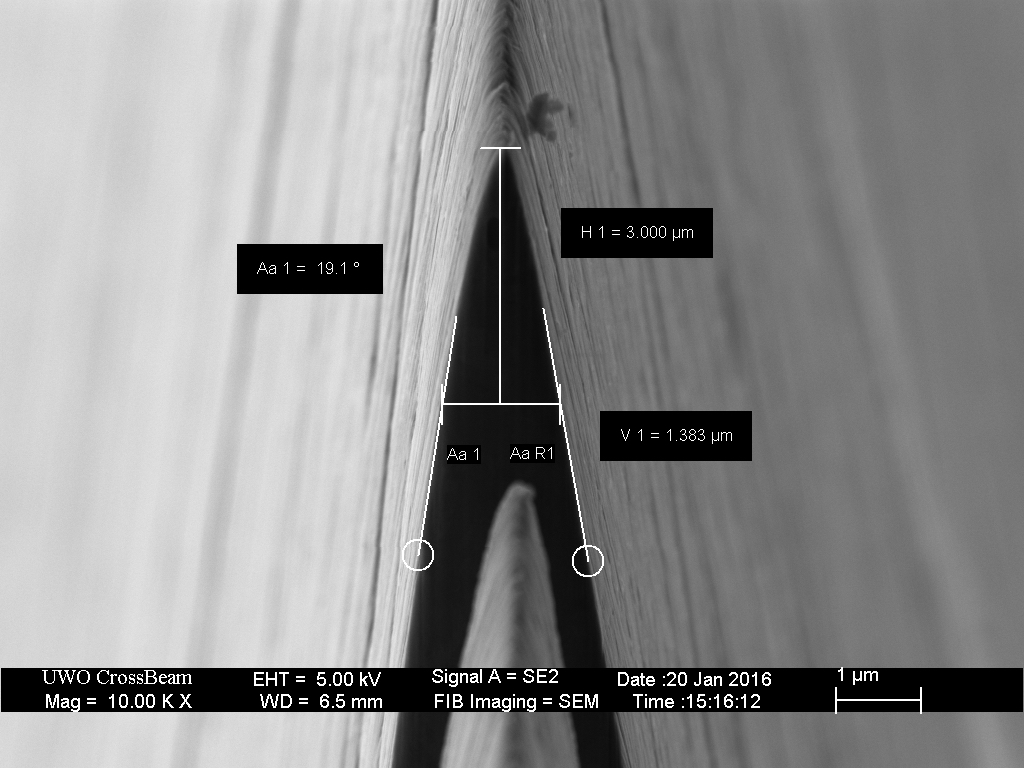

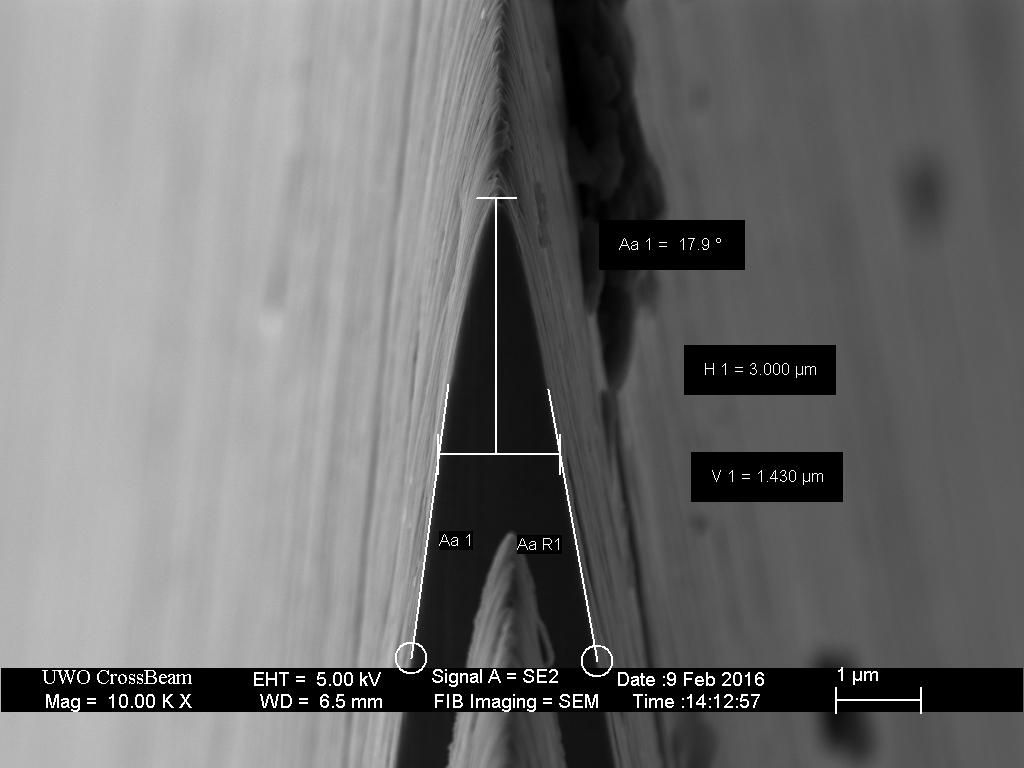



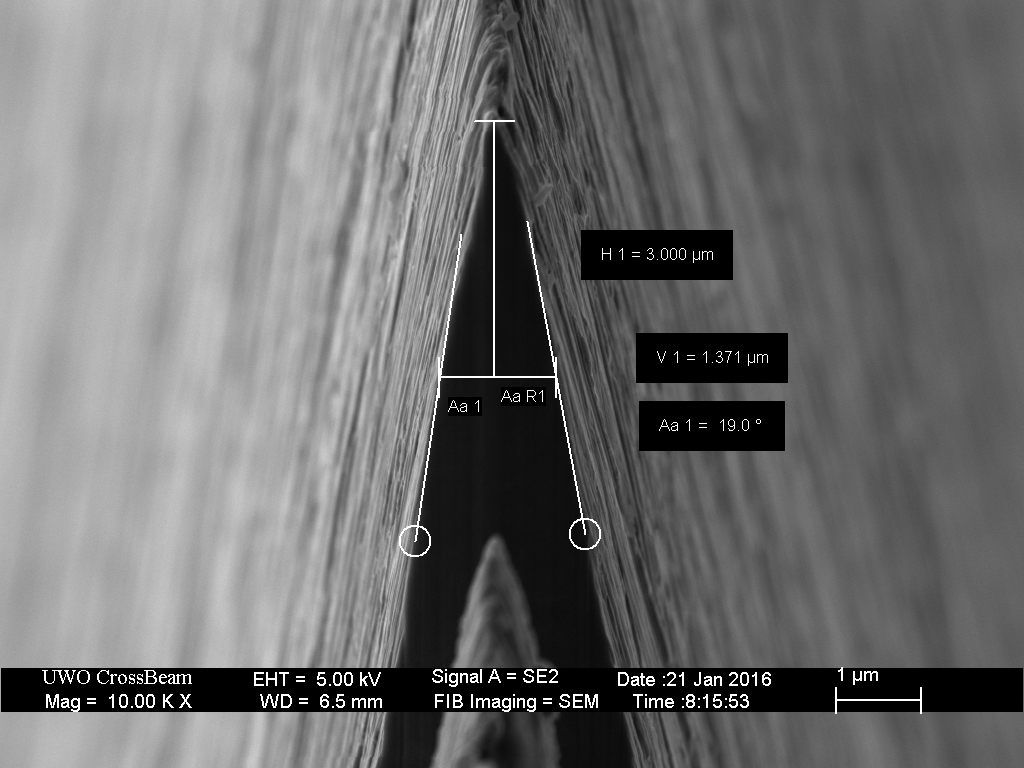
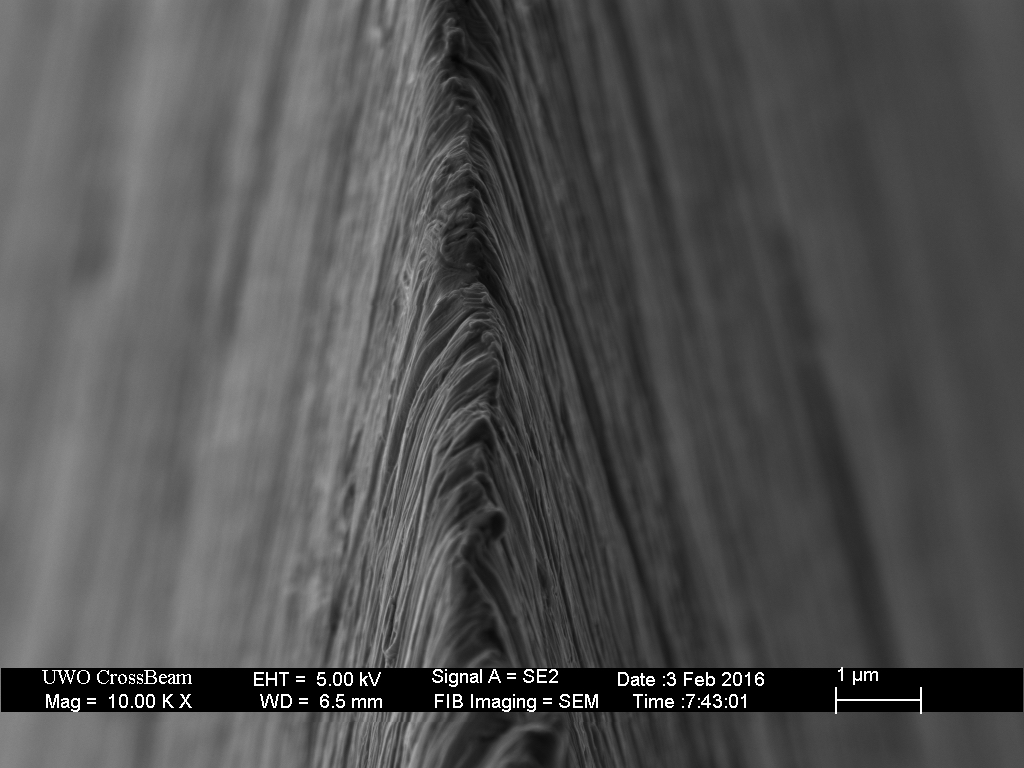

The most striking observation that can be made of this series of images is that, with the exception of the coarsest (15 micron) diamond abrasive, the amount of micro-convexity produced is insensitive to the abrasive size. There is greater apex damage with the coarsest abrasives, but not an increase in micro-convexity.
Consistent with the earlier observation with the inexpensive diamond paste, the 15 micron diamond sprayed strop produced no micro-convexity. Apex uniformity decreases with the coarsest abrasives, but at much smaller scale than the abrasive size. There is no unevenness or “micro-serrations” resulting from scratches of depth comparable to the grit size.
Observation with optical microscopy (not shown) indicates that the larger abrasives fall into the weave of the fabric and therefore do not make contact with the blade during stropping, other than glancing collisions that chip the apex at the submicron scale. The same effect was observed with diamond-spray loaded paper (also not shown). In this context, the result of the re-loaded strop described earlier can be understood. The waxy carrier fills the spaces in the fabric, preventing the newly applied larger abrasive particles from entering the weave, leaving them exposed to the blade resulting in the substantial blade damage that was observed.
None of the diamond sprays produced an increase in near-apex angle as large as is typically observed with the various metal polishes. This is most likely attributable to the oily and/or waxy carrier holding the abrasive in place and presenting it to the metal more efficiently than the water based diamond sprays.

90 responses to “The Pasted Strop – part 4”
More very interesting and thought-provoking stuff Todd. Keep’em coming!
In terms of edge uniformity, the example photos look like .5 micron compound is sort of a “sweet spot” in terms of apex uniformity – is this just a coincidence in the photos you chose, or did .5 micron actually give more uniform edges on all your test razors?
LikeLike
Keep in mind that this is for denim strops, typical of woven materials.
The results here are typical of what I observed with the other test razors. 0.5 micron seems to be the optimum for the denim strop. However, we can do much better by following it with 0.25 micron diamond on a leather strop.
LikeLike
Hi Todd,
I would like to send you some abrasive powders to have and test, and I would love to know how consistent they are. Just email me, and I will send you 3 samples.
Mike
LikeLike
I observed just the same – 0,5u paste made the most uniform and even and KEENEST edge of them all!
LikeLike
There will be variations in the size distribution between different products claiming a particular size and even different lots from one supplier.
LikeLike
Would CrOx, if good quality and size distribution, fit into this “sweet spot” on denim, or would it behave differently from diamond? I ask because I’m sitting on a sizable amount that is collecting dust since I started with Mothers and Thiers. I guess I could test and see for myself how it feels.
LikeLike
Pure chromium oxide is generally a poor choice since it burnishes more than it cuts, but the “green bar” type that is a mix of aluminum oxide and chromium oxide should work well.
In my experience pure chromium oxide is best used on a hard substrate like wood.
LikeLike
Thank you.
LikeLike
Do you mean hard like balsa or hard like oak ? I have best quality Cr2O3 rubbed dry onto balsa. In my imagination the particles sink into the balsa like you describe sinking into the denim weave- but imagination may be way off. Anyway, I can see the tiny bit of green on the steel and being dry it comes off real easy before moving to the plain leather.
LikeLike
I don’t think there would be much difference between balsa and oak in this application, the balsa is more porous, but still “harder” than a hanging strop in terms of transferring force through the abrasive particle. Loose particles have no effect, and can actually act as a lubricant preventing abrasion – this is partly why we don’t want too much compound on a balsa strop.
LikeLike
I see you noted that a micro-convexity was created on the clean denim. What about normal stropping on linen then leather, does this create a convexity as well? I thought I saw some pics of this but may have confused it with the pasted strops.
LikeLike
Micro-convexity is created on clean denim, clean natural linen and clean newspaper, although the rate that it occurs varies between materials. The primary effect of adding abrasive is to speed up the process.
LikeLike
I’m curious if you have an intuition for the speed-up achieved by adding paste to the strop. Asked more directly, given that you recommend ~30 laps on a pasted strop how many laps would you ballpark for an unpasted strop?
LikeLike
A pasted strop does 95% of what it is going to do within 1 or 2 passes. The only reason I do 30 is that I’m hitting different parts of the blade to be certain I’ve worked the entire edge. Nothing really changes after that.
At least for straight razors, it takes a few hundred laps on clean linen/leather to reach that same “equilibrium.” This is consistent with various peoples observation that a straight razor loses the character of its sharpening technique after 3-5 shaves (assuming 60-100 strop laps with every shave).
LikeLike
I’ve devoured the info you posted here so far as it is ground breaking compared that there is this dogma that it HAS TO BE MULTISTEP.
But another thing that would really interest me is the following:
I know that you are more focused on straight razors but could you by any chance elaborate on high-wear resistant steels like S30V,S90V, S110V and the effects of trying to sharpen those on non CBN/DMT Abrasives and the effects on their edge keeness/sharpness.
The common opinion is that the vanadium carbide making those kind of steels as wear resistant as they are would break off or not be fully polished if you for one would try to strop them with materials that are softer than itself leaving only CBN&DMT and that therefore a coarse edge would increase performance.
The Question i ask myself now is, is it really the case when we take high grit DMT&CBN into consideration that could effectively polish Vanadium carbide Particles in the Steel?
Or is it just the rule “Coarse Edge is Better for S**V Steels” because DMT/CBN Strops and what not isn’t too common around (non SR) knife sharpening?
Thanks!
LikeLike
There is a substantial amount of misinformation on this topic. I will be covering the misconceptions surrounding carbides and wear resistant steels in the near future. It is difficult to answer your question without first understanding the difference at microscopic scale between a keen (push cutting) edge and a textured (draw cutting) edge.
There are a few images in the links below that you may find interesting.
http://www.hypefreeblades.com/forum/viewtopic.php?f=4&t=849&start=20#p7402
http://www.bladeforums.com/forums/showthread.php/1309485-Carbides-and-cutting-edges?p=15072667#post15072667
LikeLike
So you’re implying I can add some metal polish to a piece of denim and strop 30 laps for a keen shaving edge? Say coming off a coticule for example?
LikeLiked by 1 person
It should be clear from the evidence I have shown here that this is true. Additional stropping on clean leather is required, and if you prefer a very keen edge, 0.25 or 0.5 micron diamond on leather followed by clean leather works best. I would recommend you just try it yourself…
LikeLike
I’ve got autosol metal polish. Tonight I will load a piece of denim up and take a blade that was shaving well to the strop and test this method.
LikeLike
Probably best to refresh the edge on 4-8k stone, ending in 20 or so edge trailing strokes, and THEN go with the polish, as the edge is probably already burnished or deformed from use, so the polish will have no effect. You want to abrade the foil edge off from the trailing strokes on the stone in order to remove just the last few microns of steel to form a new apex.
LikeLike
Thank you for your hard work and for your generosity to share your knowledge. It finally reveals the phenomens that take place at the cutting edge. Is there a place for Chromium oxide in a routine of sharpening and maintaining the edge according to your findings? Part of the reason I entered the straight razor world was to avoid cartridges. Buying cartridges made me feel menopausal. Now the diamond is doing a great job but is expensive and the sprays seem rather small, while the amount of crox I have is going to last a life time provided is not very long. I am experimenting with crox on denim and hanging leather strop followed by clean leather. I was doing the crox on paddle strop and clean hanging leather before. I dont see much difference but I am just starting.
LikeLike
Chromium oxide is moderately effective on a hard surface, particularly wood. A balsa-wood strop is your best option if you only have chromium oxide. Because the crystals are smooth edged, they tend to cause more burnishing than abrasion on a fabric or leather strop.
A small bottle of diamond spray will last a lifetime – you can do thousands of laps between refreshes on a leather strop.
I would suggest you try the method with edge-trailing strokes on the hone followed by stropping with metal polish on hanging denim. The diamond spray on leather is not required, it just adds a bit more keenness.
LikeLike
Thank you, I will follow your recommendation!
LikeLike
Thank you very much for sharing your time, expertise and findings with us … the sharp edge leaders … or are we the keen edge trailers? I am enjoying reading your blog.
Your SEM images are very informative. Many hours with my 50x optical stereo microscope with a quartz halogen lamp has taught me a lot, but it doesn’t show what you have shared with us. Seeing is believing for the empirically minded … especially if followed by a “good” shave.
I will soon sharpen my own skills by following your methods. I read somewhere that you can make an edge that is about twice as keen as a Feather blade (commonly thought to be the sharpest commercially available blade, because it is thin). A Feather or even a multi (five I think) Gillette Fusion blade scrape my beard off effortlessly and painlessly. My straight razor experiments have so far made an edge that is better than pulling out the hairs with tweezers, but not as good as shaving with a Feather. Now that I have a vision of what a keen edge should look like, I will aim to make my straight razor edge perform better than a Feather edge. If I succeed, I’ll be happy. You have shown us that we have abrasives that were not available to our grandfathers, so we should be able to make a better edge than was possible fifty years ago. The sharpening myths that have been passed down may work for some but we should be able to do better now — with your SEM photos to show what happens on the edge with different techniques.
Your images show that stropping a honed blade on a Mother’s Mag and Aluminum metal polish pasted hanging denim strop give a very smooth looking edge, with an increased angle micro convex edge. The image of a 0.25µn diamond paste in a similar denim hanging strop show less angle increase of the micro bevel. Is the “diamond denim” edge more keen than the “Mother’s denim” edge? You have written about the sharpness being task related. Is beard hair generally too tough for a sharp and keen 0.25µn denim stropped edge? Is the greater angle of the “Mother’s” edge more durable and useful for shaving? Is a Mother’s stropped edge followed by a few laps on a flat leather strop with 0.25µn diamond even keener? You have suggested always stropping on a clean leather strop before shaving.
I’ll compare the finishes myself … but I have to wait to find, buy and receive all the “stuff”. Patience, patience.
In the meantime, I’ll read more of your blog. Thank you.
LikeLike
I would not be overly concerned with the keenness after the denim strops, both are improved by stropping on leather, even clean leather. In any case, the purpose of the charged denim is simply to pre-convex the apex to prevent a foil edge forming with the diamond charged leather strop – the metal polish loaded denim strop is more effective for this purpose. Smooth leather alone cannot remove a foil burr, so we want to avoid one altogether.
The measured angles will depend on the force applied and the resiliency of the strop materials. The goal is to match the angles produced by the two strops – the absolute angle is not that critical, ideally in the low 20’s to balance durability with cutting efficiency. When you mention “flat leather strop” this suggests a paddle strop, which I do not recommend. What I do when stropping on the diamond charged leather is to test the blade on some very fine arm hair, when done correctly (to produce an edge keener than a Feather blade) I cannot feel the hair being cut (no “ping” whatsoever) but hairs are visible on the blade. To determine whether a foil is present you need to shave with the blade – if it is harsh or fades during the shave, there was almost certainly a foil present.
LikeLike
I have now read most of your blog… particularly Simple Straight Razor Honing which is not so simple (it’s all in the details)… but very informative and complete. Thank you. I made a summarized step by step (six steps!) set of instructions so that I would not make any assumptions and would really try to pay attention to every detail as you described the process. Having your SEM photos in mind and the knowledge of your many informative experiments gave me a vision of what I am trying to do. The rote honing prescriptions inherited from past shavers have never been encouraging for me.
Now I have more “stuff”! I tried coercing the local teenager into giving me her designer jeans for the denim. She looked at me as if I were invisible. Okay, I’m too old. A trip to the fabric store yielded an eighth of a yard of cotton denim for $1.50. I also bought some 2″ leather strips off eBay ($20), found a scrap of ⅛ ” plexiglass at the hardware store and bought some CBN from Howard Schwartz ($50). I cut the plexi into 3×11 inch pieces to use as a flexible support for the denim and leather strops, as I have a waxed counter top that does not allow taping cloth to the surface. I now also understand the value of loom strops — and how about a Washboard sharpener! A neighbor gave me the remains of a jar of “Mother’s” and he also made me a razor with a piece of 440C steel (higher chrome, almost stainless), hardened and tempered. Why not? He recently bought some equipment for making knives. I realize that 440C may not be the easiest steel to sharpen… but that if I could make it sharp, other steels would be easier. He made the blade and edge more straight than I have seen from some custom makers. It is also hard (hardened and tempered to spec). It had about a 0.1 mm thick flat edge before I started sharpening with a 400 grit Suehiro Debado stone. I had to rub that rock for hours to get a burr on the edge! A DMT 1200 seemed to just glide along the surface. The tape on the spine was replaced a few times. I followed with a Naniwa 1k (green) stone and then a 2000 grit Debado and a 6000 grit Debado. The scratch pattern on the bevel was clearly evident with 50x magnification in a stereo microscope, with a slightly rough looking edge. The edge appeared to be rounded as it glinted in the light after the final edge trailing strokes. Perhaps that was a foil burr, but it looked like a rounded edge. I proceeded to the “Mother’s” loaded denim strop which I wrapped around a piece of leather, after drying it and rubbing the cloth to remove excess dried polish/powder, before rubbing the surface with the spine of the blade (tape on spine removed). I laid the leather/denim strop on a plexiglass strip which curved like a strop when in use… for about ten ~150g force laps. Under the microscope I could clearly see that the edge had “darkened” — no more shining striations near the edge — and straightened. There was no longer any glinting, and the edge looked very clean. It looked like a Feather blade edge, except the Feather has a triple bevel with the “dark” (no striations) polished edge, whereas mine has a single bevel with a polished edge. The Feather striations look like about 4000 grit. After washing the blade to remove any “Mother’s” grit particles, I stropped the blade on another piece of leather that is loaded with 0.025 µm CBN emulsion, laid on plexi. Then I lapped the blade on a clean leather hanging strop for about fifty light laps… then shaved.
It was okay. I suppose the edge is about HHT-3… or maybe just 2. It pops head hair in an HHT test, but it does not slice it silently. The shave was close but not painless and not as good as I could have had from a new Feather blade. I need to try again. You emphasized that the most important step is setting the bevel. Perhaps I did not rub enough on the 6000 grit stone to make a foil burr. I noticed that a tiny chip in the edge did not go away… even after many laps. It seems like the 6000 grit just polishes the bevel which is about 0.75 mm wide. I will try going back to an 8000 grit Naniwa Fuji stone, which is a little softer, to try to make a micro burr before using the “Mother’s’ denim strop. Next time I will also try to use less force on the “Mother’s” strop which may be rounding the edge excessively. I will also experiment with the CBN strop, as you suggest that done correctly, the edge should “tree top” slice hairs off an arm. A friend’s beard has yielded a small tuft of hairs for my tests. Beard hair is hard to find in Summer around here.
For a future experiment, I might try to apply the CBN to a piece of paper laid on a piece of the hard plexi… adding a little curve to the plexi. The idea would be to thin the shoulder of the convex apex, making it sharper. I also bought a piece of thin ultra suede cloth which I will try with CBN, laid on the hard surface of the plexi — flat.
But first, I would like to just follow your directions again, until I get a better result. Force, pressure, number of strokes — leading and trailing — honing and stropping — and getting that pesky bevel right.
I welcome any suggestions. I have not been able to find a definition of “honing”. Do you have one? Does honing start at a finer grit than “sharpening”? Sharpen a knife, hone a razor? What about a razor rubbed on 400 grit?
Thanks again for sharing all your SEM photos and information. Most of us don’t have your specialized access to such equipment… or the knowledge
. Fifty years ago, shavers had not even heard of such equipment.
LikeLike
I did struggle with the choice of the word “simple” when I wrote this. The key is that this approach is very repeatable even with small variations in the individual steps. There are some very critical points however – you must use edge trailing strokes near the end and you must use purely hanging strops. The edge trailing strokes eliminate the usual problems of setting the bevel. If you have formed a small foil burr, you have set the bevel correctly. By attaching your strops to sheets of plexiglass, you prevent them from doing what they need to do.
The analogy I like to use is to imaging having a golf ball in your back pocket – would you prefer to lay on a thin carpet with the ball under you or in a hammock? The hanging strop is the hammock.
Do you mean 0.25 micron or 0.025 micron (25 nm) CBN? I do not recommend any abrasive smaller than 0.25 micron (250nm).
There is no universally accepted definition of “honing.” I use the term to refer to apex refinement as opposed to grinding to define blade geometry.
LikeLike
I’ve tried the technique and it worked well. I don’t recall there being anything in Todd’s method involving backing the denim and leather with plexi-glass or hard surface. I think this would limit the process from forming the necessary micro-convexity. The other thing is that you pulled the tape after the stones and before the backed stropping on denim and leather. This usually isn’t a problem and a free hanging strop but a backed one might not follow the altered bevel angle.
LikeLiked by 1 person
I should be more clear about the plexi support. It is very flexible. One end is placed near the edge of the bench and the other held in my fingers above the bench so that the denim/leather flexes like a hanging strop. I used a leather strip under the loaded denim so that the stropping angle would be the same as the leather with the CBN laid on the same plexi. I removed the tape so that the blade would slide easily on the denim and the leather. As you noted, with a hanging strop, the edge should easily meet the strop. The polished bevel — the last 0.1 mm, leads me to believe this is working.
Since yesterday, I have made a few more edge trailing strokes on an 8000 Naniwa Fuji, followed by a little more pressure on the denim and CBN strops. The hone made a very small change… not enough to remove the tiny chip. I am now at an HHT-3, maybe 4. I think the edge would be 5 if I was honing a carbon steel blade — that’s next. Making this experiment more difficult is part of the learning.
Anyone willing to define the difference between stone and hone?
LikeLike
The strop needs to defect (change angle) at the apex during stropping. Even a tubular linen strop may not deflect sufficiently for this purpose.
LikeLike
“The measured angles will depend on the force applied and the resiliency of the strop materials. The goal is to match the angles produced by the two strops…”
This caused me to wonder whether it wouldn’t be easier to “match” the angle created by the pasted denim strop with a diamond-sprayed denim strop rather than switching to leather (and being uncertain whether I’m matching the angle accurately on the less flexible leather). Is the leather substrate itself critical to achieving the keenest edge?
LikeLike
The surface texture appears to be the critical parameter. Fabric (or paper) tends to wrap around the apex – which is good for removing/avoiding burrs. Leather abrades the side of the bevel near the apex without wrapping around producing the keenest apex. So we need the fabric to remove the burr and the leather to bump up the keenness.
LikeLiked by 1 person
I’m curious, why do you not recommend a paddle strop?
LikeLike
I am referring to the simple straight razor honing method. I frequently use a rigid paddle strop with 0.25 micron diamond for knives; however, I can increase the angle and apply sufficient pressure to achieve the desired result.
A rigid paddle strop with smooth leather does not make sufficient contact with the apex of a straight razor. The kangaroo paddle I use for knives has absolutely no effect on a straight razor. A flexible paddle strop (fixed only at the ends) or one made from rough leather will work, but it will be challenging to find the correct force. A hollow ground razor will flex and lift the apex off the surface if we use more than light force. By using a hanging strip of denim and a hanging strip of leather, you can use the same pressure on both (or slightly more on the leather) and the result is quite forgiving to the various conditions.
LikeLike
Thanks for clarifying that.
LikeLike
Thank you for all your work. I have a sort of simpleton question. When you say strop with denim, does that need to be heavy duty denim tubing or canvas, or can it be something like old jeans? Thanks for any help.
LikeLike
I just cut a strips from old pairs of Levi’s 501s.
LikeLike
Thanks.And sorry about the double post.
LikeLike
“I do not recommend any abrasive smaller than 0.25 micron (250nm).”
Care to elaborate?
LikeLike
I’ve tested a variety of 100 nm abrasives on a various substrates, and consistently observed a reduction in keenness. Prior to developing the denim with metal polish approach, I used 100nm CBN on leather as a burr-removal step. Forming a foil edge with 250nm diamond on leather, removing the burr with 100nm CBN on leather concurrent with a reduction in keenness, then restoring the keenness by stropping on the 250nm diamond on leather again.
These sub-250nm abrasives can be very effective at producing a mirror finish, however.
LikeLike
I have still not mastered your system… but I am a believer, making progress and learning a lot from your experience. Thank you again for sharing all your observations and the SEM images. I think I now have a sharp edge but it is not yet keen enough to match or beat a Feather blade. I am missing the diamond step.
In your tests, you observed that 100 nm abrasives polish the micro convex edge, much like finer than 8k grits are effective at producing a mirror finish on the bevel — without necessarily making it sharper.
I had some 0.25 µm diamond spray called Dupont which I bought a few years ago. It makes nasty scratches on the bevel, so it is useless for razors — poor quality control. I did not know that before I bought some cBN 0.25 µm recently (sorry about calling it 0.025 µm in an earlier post) but that seems to be a “polisher” too.
I see that Ted Pella sells 0.25 µm diamond grit in a spray and in a syringe, poly and mono crystalline. Choices, choices. Which do you recommend? I presume you have endured the expense of buying them all!
While I wait for the products, I have been playing with what I have. I rubbed some silicon carbide 4000 grit paste into a sheet of printer “copy” paper, rubbed it in with paper towel, then placed the sheet of paper on a sanding screen (the type used for sanding drywall) laid on a hard flat surfaced wood block. The sanding screen makes very fine irregularities in the surface of the paper. My thought is that the grit cuts all the way to the edge because of the “corrugation” in the surface which raises the pressure on the edge. A few gentle edge trailing strokes over the paper with my razor makes a very nice looking, sharp scratch pattern in the bevel, finer and crisper than 8k aluminum oxide. The result pops hair. I imagine that any larger grit embeds into the paper, much like the larger Mother’s aluminum oxide grit particles sink into denim.
LikeLike
The 0.25 micron cubic boron nitride, in my experience, performs equivalently to both poly- and mono-crystalline diamond at the pressures we use for honing and stropping. I would expect that batch-to-batch variations in size distributions will have a larger effect than the type of particle.
I use the 0.25 micron CBN and the Ted Pella diamond spray interchangeably – I would suggest you spend a bit more time with what you have rather than buying something else. It may be that your leather strop needs some break-in laps with a screw-driver shank.
If you are not achieving “Feather Blade” levels, the problem is most likely with the diamond/leather step, or possibly too much pressure with the metal polish/denim strop. I would suggest testing the blade by attempting to tree-top arm hair after every 5 laps, starting with minimal pressure and slightly increasing each time. The ultimate keenness comes from just removing that last bit of metal burr from the apex.
I have experimented with diamond spray on paper, and it behaves very much like denim – larger particles are embedded and play no role.
LikeLike
SUCCESS! Thank you for your support. My CPM 154 stainless steel edge is now as good as a new Feather edge and a vintage carbon steel blade is much easier to sharpen.
I have been refining my technique (within your parameters) by using less pressure and more strokes — and a lot of looking under a stereo microscope to make sure the entire magic marker blackened bevel is sharpened all the way to the edge, from heel to toe. The rounded edge likes to hide! I used an 8k Naniwa Fuji and 10k Suehiro Gokumyo (because I have them) to refine the bevel by making a thin slurry by rubbing the 8k with the 10k stone, then using the 10k stone with a thin 8k slurry which I thinned out to just water on the 10k after wiping the surface to remove any bits of burr from the stone surface, to avoid making a new chip in the edge. I finished with about twenty laps of edge trailing strokes, then polished the edge very lightly with the Mother’s pasted denim strop (about ten laps), followed by about twenty slow and careful laps on a 0.25 µm cBN pasted leather strop and finally about ten laps on a clean leather strop. A vintage carbon steel blade takes fewer laps at every stage and shaves painlessly. I don’t yet know if the CPM 154 holds its edge longer than a carbon steel edge.
Under a stereo microscope at 12x and 25x, I noticed the familiar look of the perfect Feather blade edge which appears dark a few microns from the edge, with no glinting burr beyond the edge. Now that I have your high magnification SEM images in mind, the 12x gives a good indication of what is there. The polished dark edge, from using the denim and leather strops, looks different from the scratched bevel. With the light source angled appropriately, the dark polished edge is easily noticeable. Any burr, chips or deep scratches show immediately — very annoying.
My struggling with sharpening a razor edge has given me a much better understanding of edges for knives. My kitchen knives respond well to the Mother’s denim strop after finishing on an 800 – 1000 mesh grit (Corundum sandpaper or stone).
A bearded friend has donated some whiskers for HHT tests. Big thick red Viking hairs pop off easily, half an inch from the suspension point.
The final result is my smooth face, and happy, admiring lady.
Thank you for your guidance. Your SEM images and experiments have taught me more than any of the magical mystery tours that I have tried to follow in the past.
LikeLike
I’m glad to hear you have made this breakthrough. I would suggest that you also try HHT tests with very fine hair for comparison.
LikeLike
Clive, interesting post. As far as your kitchen knife is concerned, did you do edge trailing at the end? I find it a bit difficult to strop on hanging denim (less so on hanging leather) near the tip since it “digs” into the denim. Did you go all the way to the diamond on leather for the kitchen knife? Thanks!
LikeLike
For the kitchen knife, I used edge trailing strokes for the final ten or so strokes, just as Todd recommends for a razor. Stropping the blade with a few light strokes on the pasted denim strop is probably more than is needed for a kitchen/utility knife, but I did it to feel the result. If the stroke is very light (that is all that is needed), the tip toe should not dig in. If the blade is long, you can pull the pasted “rag” (strop) over the edge under its own weight to remove any burr. A kitchen knife with a 1 µn edge is sharp by any standard, but that is ten times more blunt (less keen) than the minimum required for a razor edge if the razor use is to be less painful than pulling out the whiskers with tweezers. I stropped the knife on leather too, but it was probably not necessary and I don’t know if it made any difference. Making a razor sharp is a special skill and it was difficult for me until recently, thanks to Todd’s revelelations.
LikeLike
Todd,
Now that I have a useful shaving edge, I am curious to push a little further and widen my experience.
Will a Gokumyo 20k or 30k stone improve the sharpness? I don’t have either.
I finished my razor on a Gokumyo 10k stone (which I have) before using the polish pasted denim strop and cBN leather strop. Success.
I notice that you finish with a Shapton 16k, and sometimes a Gokumyo 20k, but that you have also finished on 325 and 8k stones before the denim strop with good results. I think you have indicated that polishing the whole bevel is not important for shaving, as long as the last few microns of the bevel have the correct geometry and a burr free edge.
Is there a benefit to finishing on a finer than 10k stone before using the denim strop?
Your micrograph of a triangular bevel from a 20k stone looks very sharp. It occurs to me that following the 20k with very light strokes on the denim strop might make an even better edge — sharper and keener than from a 10k. Is that so?
You have also written that a Coticule edge is just about perfect. Do you follow the coticule finish with a clean leather strop — or does the pasted denim and cBN stropping still apply? Does an Escher give a different result from a Coticule if followed by the pasted strops?
LikeLike
If you want to create a triangular apex (not micro-convexed by stropping) with sufficient keenness for shaving, then a Gokumyo 20k is the best (easiest) option.
Personally, my beard is too coarse to shave with a blade prepared this way (the apex angle is too low and they do not survive a single shave).
I have a Gokumyo 20k (somewhere under my sharpening bench) and it’s been a very long time since I used it for anything other than experiments. I have typically used this hone as a “control” to show the effect of other stones/hones/strops. There is very very little difference (less than 1/10 of a micron) between the apex formed by edge-leading strokes on the Shapton 8k and the Gokumyo 30k.
Since stropping on abrasive denim will form a new apex a few microns below, these differences are of no consequence. I have gone from the Shapton Pro 320 (edge trailing) directly to the denim strop with several razors and the results were indistinguishable from that produced by higher grit hones, both by SEM measurements and shave-testing.
If done correctly, a Coticule honed razor only needs a clean leather strop to finish.
LikeLike
Hello. Thank you very much for your efforts and for this blog. Can you please expand on “If done correctly” with regard to coticule honing? What is your “correct” process – with slurry / without slurry? Dilutions or no dilutions? Edge leading or edge following? What clues inform you it is “done”? What pressure do you use? Thank you in advance.
LikeLike
Todd,
Your research is mind blowing. I’ve read all of your articles, and I feel enlightened! It totally changed the way I understand honing. Thank you.
I still couldn’t try your simple razor honing method, because my diamond spray is still in mail. However I’ve been experimenting with the honing and AlOx denim stropping parts, i.e. first two steps.
After finishing with edge trailing strokes on a Shapton GS 8k as you described, I continue with a denim strop loaded with TI pate a rasoir. I haven’t achieved a shaving level comfort yet, even though I observe that tree topping of arm hairs and HHT is greatly enhanced this way, more than I’ve ever got. This is curious. Am I achieving high level of keenness, with a very low level of sharpness? I hypothesized that I’m micro convexing the apex too much.
Also, I’m curious, why is a foil burr needed before forming the micro convex apex. Why can’t the abrasive denim strop do the same thing to a triangualar apex?
LikeLike
Within my definitions of keen and sharp, yes we give up a bit of sharpness to improve keenness. When you strop on the strip of denim loaded with TI pate a rasoir (or any metal polish, there is very little difference between the common varieties) you create some micro-convexity while making the apex narrower and more uniform. The amount of micro-convexity is mostly determined by how much pressure you use, so you can reduce this by simply applying less pressure. This is something you can experiment with and test by attempting to tree-top your arm hair.
The diamond spray is not absolutely necessary – you can achieve almost the same result with a clean leather strop. In any case you do need to strop on clean leather before testing.
You are correct that a triangular apex is sufficient for this procedure; however, it is not always easy to produce a triangular apex. For example, the 6k side of the King combination hone doesn’t produce a suitable apex by edge-leading strokes alone. There are a number of pitfalls in honing and stropping that I haven’t discussed that are avoided by following the procedure as described.
LikeLike
I finally received my Mother’s polish and gave your “simple honing method” another go. The result was the sharpest (or should I say keenest) edge yet one of the most comfortables, if not the most. I’ve been honing for a year, and I hadn’t come close to this level with my synthetic stones, JNATs and CrOx. The way I look at honing has completely changed. Now it’s not about grits, scratch patterns, sizes, but the geometry at the apex. Thanks again.
After gaining some experience with the Mother’s polish, I’ll give TI pate a rasoir another go.
LikeLike
I’m glad to know you’ve had success with this approach.
LikeLike
As far as knives go, I find it fascinating that Rockstead Knives advises the use of a denim strop loaded with polishing compound as the best maintenance and uses them in their demonstration videos.
Their knives are renowned for their edge–as well as their price!
LikeLike
Thanks for pointing that out, I’ve not seen that before. I have used and tested Pikal, and it’s performed similarly to the metal polishes that are more common in North America.
LikeLike
Your website is really a great place to get lots of information about everything concerning razor blade sharpening. Very informative!
I personally use a pasted leather strop with iron(III) oxide to give my straight razors the final touch. I found a special artists oil colour from the German manufacturer Schmincke (Terra Rosso) which contains very fine iron(III) oxide particles that makes it very suitable as strop paste for this special job. Fe2O3 is quite less abrasive than chrome oxide and therefore achieves better stropping control and results in a really smooth and sharp edge. I also use this pasted strop to resharpen my straight razors of they get a little bit dull after longer time of use. The results are really satisfying.
Best regards
Norbert
LikeLike
Infinite Thank-You for sharing all of this hard-won information. I hope to use some of these insights to sharpen my knives in the near future. In many cases, your results are completely unexpected, counter-intuitive, and mind-blowing.
Thanks again!
LikeLike
Ahh…that’s the visual in needed. Makes perfect sense. Thanks!
LikeLike
Hi Todd,
In summary diamond spray with balsa or denim is the best method to ensure the diamond is absorbed in the strop? What type of diamond spray and what mircon would you recommend after the 8k process?
LikeLike
Ideally, we don’t want the diamond to be absorbed, but to adhere on the loose fibers at the surface of the leather or wood. I have the best results with sanding the surface to medium grit and then using the shop vac and compressed air to remove any dust and abrasive. For leather, I find it helps to wet the surface with iso-propyl alcohol first. I usually just wipe it around with a gloved finger and let it dry. We don’t want to plaster the surface so that the loose fibers can move around when we strop.
I haven’t found any advantage to “expensive” diamond emulsions. Any 0.25 micron (or 0.5 micron) diamond or CBN on leather should work well after a fine stone.
LikeLike
“I have the best results with sanding the surface to medium grit…”
The reverse side of my Latigo strop has a very short, uniform nap. It behaves like velvet when brushed (you can see difference in texture where disturbed). Would such a nap be too long to accomplish the final keening with diamond, i.e. will it wrap around the apex like cloth?
LikeLike
I would expect a suede nap would wrap around the apex. We want a relatively smooth leather where the texture is just the micron-scale fibers.
LikeLiked by 1 person
Hi Todd
So preparing the leather or balsa by sanding before applying substrate will ensure that it will not be absorbed? What type of leather would you suggest?
LikeLike
In both cases we want to have the the surface fibers loose and mobile. The problem with leather is usually that the emulsion beads up and doesn’t wet the surface – sanding and wiping with alcohol usually helps with this.
I’ve tried a variety of leathers and not found that any particular type is measurably superior.
LikeLike
Hi Todd
Is balsa wood preferred over leather to keep the substrate loose?
LikeLike
I have found that leather consistently performs better than wood, but the advantage of wood is that is easier for stropping chisels or plane blades (due to the sharp corners).
LikeLike
Hi Todd
For razors leather would be the best? What grit of sandpaper do you use to prepare the surface of the leather and how should it look and feel after preparing it?
LikeLike
I believe leather is the best substrate for stropping any blade. For the diamond emulsion strop, I would suggest 180 or 220 grit sandpaper. Essentially you are making nubuck, but with use it will flatten/smooth out.
LikeLiked by 1 person
Honestly – this should be required reading for any professional sharpening service and/or straight razor enthusiast. Very Good work!
LikeLike
BTW: Do you have any experience with the Dovo Green, Red, and/or Black pastes? Due to their low cost – they are a product I get a lot of questions about…
LikeLike
I’ve not used those specifically. I’ve lost interest in analyzing various compounds – my observations suggest that the strop material dominates the effect.
LikeLike
Is rouge or red iron oxide a valid cheap stropping compound option? I tried it by spreading a water mixed paste on a piece of softwood. After drying just stropped on it and got a visibly polished HHT3 edge on an ancient razor of questionable quality. I am curious of it’s micro-scale properties, as I remember reading about it and because it fails to create strong crystalline structures it breaks down into a very fine powder that ends up being a atomic/molecular polishing agent. Would this be of interest for you to test?
LikeLike
I know people use it, but I think it primarily intended for polishing jewelry.
LikeLike
The most important discovery I made during 65 years of shaving with blades is don’t use a mirror other than for admiring the end result.
Get used to feeling the blade over your skin and soon you will never nick yourself again. You no more need a mirror for shaving than you need one to find your mouth with a fork.
LikeLike
Todd: I have been much enjoying your Blog, and have been “dosing” myself with parts of it almost every day. I can only read so much, and then I feel the need to take a break, and do something active, like sharpening a knife!
My sharpening interests are wide, but I most focus on conventional knife blades, either straight or folding.
I am now enjoying your series on stropping. With four episodes and counting, that represents a lot of interest on your part.
My equipment has recently included a PT50A for testing sharpness. I am reminded of a quote from my “scientific” youth: “…If it isn’t measured, it’s ignored…..If the measurement isn’t recorded, it’s forgotten…” I now try to take frequent BESS measurements and record the “sharpness,” and how I got there.
Like you, I have found HUGE improvement in sharpness with stropping.
Can you offer a specific program using the “best practices” for stropping a knife? I am particularly interested in whether I should add a “hanging strop” to my collection of “mounted strops” that are anchored flat.
How “far back” in the progression should I go to initiate trailing strokes on the stones?
Is the resilience of the 3M film too much to use as a substitute for stones in the best progression for sharpness?
Thanks in advance, Scott
LikeLike
For a knife, I prefer a hanging strop simply because it provides much greater control of angle and pressure once you master its use. After years of daily stropping a straight razor, I find the motion very natural, much more so than stropping on a hard paddle. For chisels though I use a piece of (non-corrugated) cardboard.
That said, I’ve experimented with most of the various permutations and they all do the essentially the same thing, so it’s really a matter of choosing the one that is most comfortable for you.
It’s difficult to make generalizations about edge trailing vs edge leading – it’s something you need to evaluate for the particular steel/stone/angle combination that you are using.
I’ve had good and bad results with lapping film, not entirely sure why, but there are several varieties/formulations and I’ve never systematically compared them.
I don’t think the “resilience” is an issue – micro-convexity doesn’t result from bulk compressibility of the substrate, it results from the compressibility of loose fibres at the surface.
LikeLike
Thanks for the thoughtful and speedy reply Todd!
Your vast experience seems in line with the little that I now know, in that physical dexterity is so important, especially when working “unguided.”
Part of the joy of sharpening for me is the feeling that I am gradually mastering the “mechanical” aspects where my mind guides my hand, and the feedback from the hand tells my mind whether or not I am developing skill at the task.
Sure, I could use a guided system, but that would be like a painter using a computer to guide his brush: the job might be “better,” but it’s not “personal.” I am trying to develop an intimate eye/hand/brain relationship, not just get a sharp edge.
Your blog offers me a way to guide myself along that path.
Many thanks !
Scott
LikeLike
Hi Todd
How would stropping on a roll or pile of newspaper be? Will it produce a nice clean, burr-free, slightly micro convexed edge similarly to the edges you showed above? (Given that the knife is sharpened with no or very small burr formed in the first place).
I kind of suspect that a roll or pile of newspaper would replicate a leather loaded with polishing compound. If it doesn’t, what would you suggest for finishing the knife after a whetstone? (My current sharpening method is finishing the knife with several very very light edge leading strokes on a stone as the last step).
Thank you.
LikeLike
It’s important to understand the difference between convexity and micro-convexity. Convexity can result from soft strops like a “pile” of newspaper (although it might take a while). BUT micro-convexity results from the loose fibres on the surface of the paper. You only need a single sheet of paper wrapped around a hard substrate to achieve this.
LikeLike
I see, I might have mixed the terms up.
In the past weeks, I tried stropping my knife on a roll of newspaper (pretty compressed), mostly with just 5-6 pairs of stroke. When I tested the edge with my fingers, I could feel that the knife is considerably duller. Could this be that I rolled the edge or create an overly convexed edge?
Btw, by “a pile” I mean a stack of newspaper.
LikeLike
I won’t speculate on what you are doing; there are too many variables. But I can tell you that I’ve had good success with diamond spray on a sheet of paper, as have many others.
LikeLike
Thanks for your speedy reply. I decided to purchase a paddle leather strop to try to see the differences.
LikeLike
All are abrasive make damages! You have discovered what it was my first mistake when I first used this garbage! Was it necessary to use a microscope to see the razor has lose the sharpness? The web is full of people used this horrific paste put in sell by Thiers Issard! I have one completely new! Never used!!!! You should be very testard to use The Thiers Issard! I bought the more expensive and I know exactaly their quality! Very horrible! I should be curious to see you shaving with a Thiers Issard!!!!!!
LikeLike
Looking for clarity on what you mean by “clean” when describing a leather strop. It seems to me that loading with 0.25 micron poly-diamond spray would work best on un-oiled/un-waxed leather, possibly sanded/smoothed as you describe in earlier comments and the final stropping on “clean” leather to impart the nano-scale lubricant would need to be on an oiled/waxed leather. Do I have this about right?
For what it is worth I would give your Science of Sharp page a 10 ouf of 10 or even a Top Ten of all the serious web pages I have ever studied. Stunningly good work here. Thanks.
LikeLike
At microscopic scale, leather is a mat of fibres that are stabilized by oil/fat. This makes the surface hydrophobic and therefore prevents spray from wetting and spreading easily. We can expose fibres from that surface by light sanding or by stripping some oil away by rubbing the surface with an alcohol dampened cloth to allow the spray to wet. In my experience this is only temporary as oil will migrate to that surface with use (stropping). Alternatively you can just rub the liquid around with a gloved finger until it dries. It seems that after some use they all end up in the same state. As a result, even the diamond loaded leather should have a fat/oil surface that transfers to the blade. However, in practice, I always observe an improvement to the HHT performance when following the diamond loaded strip with a clean strop.
LikeLike
Thinking of it I’ve got a question on stropping pressure. You use a weight equivalent, which makes sense in the context of how hard one is pressing down on the razor while stropping. What about how much tension you put on the strop itself? This could range from minimal resulting in a large catenary curve to the strop to a taught tight straight strop. Can you describe how much tension you use? (no need to get out the spring scale …)
LikeLike
You can use both the tension and downward stropping force to adjust the pressure at the apex. I tend to judge this by feel and sound but it is typically in the range of a few pounds of force. For knives I lay them flat to the strop and use these to bring the apex into contact so there is a large range of adjustment possible by adjusting those two forces. This is why I rely more in feel and sound than trying to quantify those forces.
LikeLike
do you get the same foil burr stropping from toe to heel as heel to toe? in theory the striations will then be oriented same as when edge leading heel to toe correct? im assuming stropping toe to heel just creates the same edge trailing foil burr but i dont remember reading this anywhere?
LikeLike
Striations are of no consequence.
LikeLike
Hello, after reading part 4 of your article, and thanks for the synopsis of the prior parts which I found informative and sensible, I think it confirms my more recent sharpening technique with great success which is to a mix of forward and backwards motion. Thereby minimizing any form of burr. Also // to the edge motion produces a very keen edge immediately. A few subsequent strops with the lightest pressure possible to avoid dimming it seems alright.
I was about to purchase a leather strop and compound when I found your article and thought denim, of course. Per the conclusion though, I immediately went to a silk/wool shirt for the ultra fine weave to improve the efficiency and as a backwoods approach of using what’s on hand, sanded some sandpaper with a mix of grits because why not. So 2k and 4k, sanded together every which way to loosen the grit from it, then patted them down onto the sleeve of a silk/wool shirt. The shirt is a dark navy blue and it’s obvious via contrast that I got a good layer of abrasive down.
From your article you’re starting with a very fine result. My final is a 1000 diamond block from 400. I still have some small chips in the blade from cutting cans with it. But apart from that it’s slipping through paper cleanly. So too another knife I’d been working on for kitchen work. I could now do a clean pass shave on the arm hair and feel the edge gripping as it goes. Prior to it’d slide over the skin and just pop a few hairs.
I used it dry and the grit builds up on the knife a little and gets lifted around that way but it doesn’t get lost within the weave. I think I”ll throw some 1k grit on based on your results as well. The silk wool should offer good dampening as well and while it could seem gimmicky it might be the first “silky” blade edge. Seems the material could have the ability to impress at least those dampening and roughness aspects of its character onto the edge.
As a laugh, for audio electronics I use silk impregnated audio grade electrolytics called Silmics from Elna and they’re the best you can get, not the lame audiophile stuff. There too, the damping characteristics of the fabric impart themselves onto the edge although in that case it’s of the signal, which helps correct it from prior abrasion.
Thanks for some fine work. Think I might use the silk wool instead of a leather and get some metal polish for it. Used to use the mother’s mag polish with coconut oil to condition and spread it with. Pretty good edge on a leather that way. I might soak a piece of silk with that and it can probably be washed with dish soap and reused. Of course, it might hold up to wear better than leather as well. As well I find sanding the leather down by hand to correct for nicks in it affects the flatness and then it’s more of a bother. So it might have a great benefit to go with fabric strips that can be easily replaced and there’s plenty of that in a single shirt or the like.
Another interesting idea is some type of polymer could be used to stiffen it right up. That’d be kind of a hybrid product. Or I suppose a freezer might work if it were done quickly. As well the coconut oil is already a paste at room temp, and so a cool workshop would suffice. I didn’t really get that affect previously since I melted the oil into the leather. But I think a thicker waxier coating would be more efficient at cutting as you say.
LikeLike